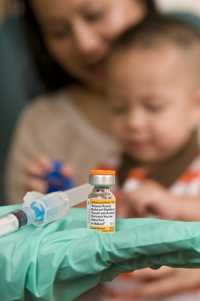CDC Protects People from Disease and Injury
Back in 1946, the Communicable Disease Center, as the agency was then known, was created from a wartime agency devoted to malaria control. Today, the nation′s prevention agency works 24/7 protecting people from diseases, injuries, and disabilities, as well as other health problems associated with natural disasters and bioterrorism attacks.
A Strong Public Health System is a Critical Investment
If experience is the best teacher, then CDC′s rich history has served to further strengthen and prepare public health experts for what lies ahead. What we do know is that we cannot afford to lose our momentum in preparing for the unexpected. Whether we are talking about infectious outbreaks that threaten our economy and security or preventable chronic diseases that drain our productivity and quality of life, the cost of failing to maintain a strong public health system would greatly affect the national bottom line.


Features
Disease Detectives at Work—Detecting Salmonella Infections from Backyard Flocks
A growing hobby of people around the country is to keep live poultry (chicks, chickens and ducks) in backyard flocks. This trend may be contributing to an ongoing increase in Salmonella outbreaks linked to these birds. In 2012, eight outbreaks of human Salmonella infections from contact with live poultry obtained from mail-order hatcheries occurred in the United States.
CDC Shares Public Health Articles on CDC Stacks
CDC Stacks is a free, digital repository of publications produced by the Centers for Disease Control and Prevention (CDC) based on scientific research. This online library can be found at http://stacks.cdc.gov. CDC Stacks is composed of curated collections of full-text peer reviewed articles, guidelines and recommendations, and many more documents on a broad range of public health topics. The documents are retained indefinitely and are available for public health professionals, researchers, as well as the general public.
CDC Ramps up Support for Final Push in Global Polio Eradication Effort
On Wednesday, December 14, CDC Director Thomas R. Frieden, M.D., M.P.H., charged the entire CDC community to become active participants in an intensified strategy to eradicate polio, worldwide. The briefing followed Dr. Frieden’s December 2nd announcement activating CDC’s Emergency Operations Center for the agency’s partnership engagement through the Global Polio Eradication Initiative (GPEI). GPEI is committed to eradicating polio by the end of 2012.
Vision, Duty and Confidence Creates a No-miss Laboratory
Few stories cast the laboratory scientist in a leading role. However, laboratorians across the nation led in the response to the intentional release of anthrax through the mail in 2001. This crisscross of highly prized experts was trained to be able to detect anthrax in lab specimens, with uncompromising precision, by CDC's Tanja Popovic, M.D., Ph.D.
Anthrax response in DC: Very Intense
Rima Khabbaz, M.D., led the CDC field team to the nation's capital during the public health response to the anthrax attacks of 2001. "I would characterize that time as very intense, we were acutely aware that we were dealing with an intentional attack, and focused on doing all we could to try and mitigate the consequences and save lives."
“Please tell me, is it safe to go home?” After 9/11, science offers comfort
The listening skills honed years earlier at a kitchen table on Long Island helped Rear Admiral Sven Rodenbeck, Sc.D., recognize the comfort his science could offer the people of Lower Manhattan following 9/11.
From forest fires to terrorism: A champion for structure within chaos
Rear Admiral Scott Deitchman, M.D., M.P.H., actually is able to see the forest for the trees and has diligently championed more coordinated emergency response at CDC since his work with forest fighters in 1988.
The learning never ends: Disease detectives follow every lead
By the fall of 2001, Daniel Jernigan, M.D., M.P.H., knew his way around respiratory disease investigations. As a seasoned epidemiologist, with the CDC since 1994, Jernigan liked the hunt—who was getting ill, was there a cluster of cases, what relationship did patients have with each other, how long were they ill, when did symptoms begin, what was the attack rate?
The real question was, “Will this hurt someone?”
Not many people can bring up the risks from inhaling anthrax spores, microwave popcorn flavoring and nano particulates in the same conversation. CDC's Ann Hubbs, DVM, Ph.D., is that person. Hubbs was selected to respond to the 2001 intentional release of anthrax, in part, because she had a unique professional background.
Interview with James M. Hughes, M.D.
Read an interview with Dr. Jim Hughes, infectious disease expert and former director of CDC’s National Center for Infectious Disease.
- Page last reviewed: March 19, 2014
- Page last updated: March 19, 2014
- Content source:


 ShareCompartir
ShareCompartir